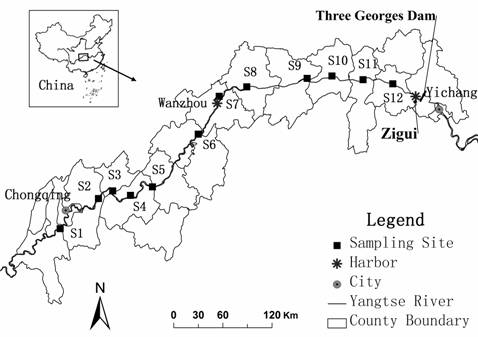New Progress in Assessing Soil Heavy Metal Pollution in Water-level-fluctuation Zone of Three Gorges Reservoir, China
2011-05-30
With the completion of the Three Gorges Dam, the Three Gorges Reservoir (TGR) inundates a total area of 1080 km2. The water level of the reservoir fluctuates from 145 m in summer to 172 m in winter, resulting in formation of the water-level-fluctuation zone (WLFZ) with an area of 350 km2 in the reservoir. There are concerns that heavy metal from industrial activities and domestic consumption in the uplands may be carried on to and accumulated in the WLFZ by floods. Previous studies have reported that soils in the upstream of the TGR were polluted by industrial wastewater and domestic sewage from Chongqing city, an industrial center in the adjacent area with a population of 32 millions. In the downstream of the reservoir, intensive land use has increased non-point pollutants in the reservoir region. However, there is little information available about the heavy metal distributions in the WLFZ particularly after prolonged submergence.
PhD student Chen Ye from System Ecology (Prof. Quanfa Zhang’s Goup) of Wuhan Botanical Garden, CAS made an investigation on heavy metals in the WLFZ of the TGR and their relationships with floods by collecting soil samples in 12 sites along the WLFZ and further determining the source apportionment of heavy metals (Hg, As, Cr, Cd, Pb, Cu, Zn, Fe, and Mn) using a receptor model. Results demonstrate that spatial variability in heavy metals before and after submergence and elements of As, Cd, Pb, Cu, and Zn are higher in the upper and low reaches. FA (factor analysis) and FA-MLR (factor analysis-multiple linear regression) reveal that As and Cd are the primary pollutants before submergence, and 45% of As originates from domestic sewage and 59% of Cd from industrial wastes. After submergence, the major contaminants are Hg, Cd, and Pb, and traffic exhaust contributes 81% to Hg and industrial effluent accounts 36% and 73% for Cd and Pb, respectively. The results suggest that shipping and industrial wastes should be regulated to protect the WLFZ in the Three Gorges Reservoir. This research has already been published in Journal of Hazardous Materials.

Location of the sampling sites in the water-level-fluctuation zone of Three Gorges Reservoir